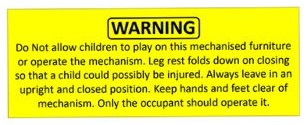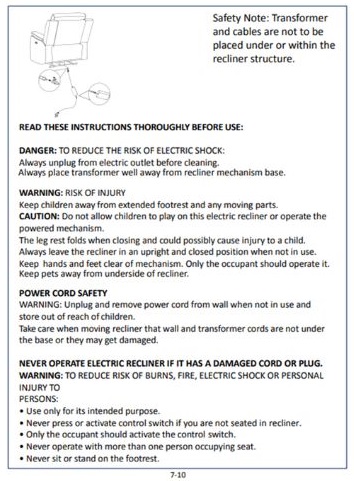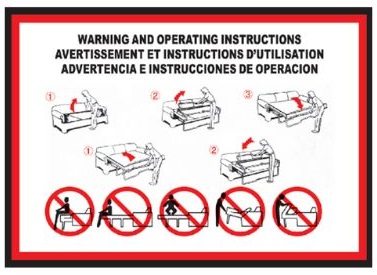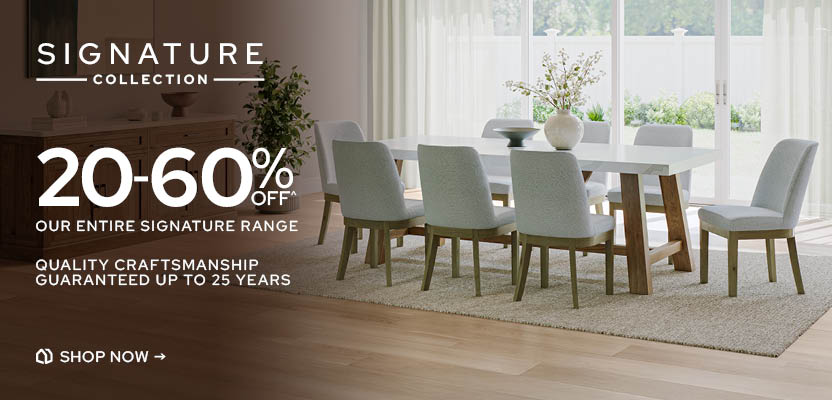Leather Sofas
Care Instructions for Leather Lounges:
Regular Dusting: Dust and debris can accumulate on the surface of leather lounges, so it's important to regularly dust them using a soft, dry cloth or a vacuum cleaner with a soft brush attachment. This helps prevent scratches and keeps the leather looking clean.
Spills and Stains: Act quickly if any spills occur on the leather lounge. Use a clean, dry cloth to blot the spill gently, avoiding excessive rubbing which can spread the stain. For liquid spills, avoid using water directly on the leather. Instead, use an approved leather cleaner.
Cleaning Products: When cleaning your leather lounge, use Amart approved cleaners for leather upholstery. Do not use generic leather cleaners or saddle soaps. Avoid using harsh chemicals, detergents, or abrasive cleaners as they can damage the leather. Always test any cleaning product on a small, inconspicuous area before applying it to the entire surface. High wear areas such as the headrest, backrest, armrests, seat and footrests will require more frequent cleaning as these will come in contact with your skin and come susceptible to dirt, grime and acids from the skin. Without proper care and maintenance this may lead to damage to the leather coating which may cause your leather to peel.
Conditioning: Leather tends to dry out over time, so it's important to regularly condition your leather lounge. Use an approved high-quality leather conditioner and apply it using a soft cloth, following the manufacturer's instructions. Conditioning helps to maintain the leather's suppleness, prevent cracking, and extend its lifespan.
Sunlight and Heat: Direct sunlight and excessive heat can cause leather to fade, dry out, and crack. Avoid placing your leather lounge in direct sunlight or near heat sources such as radiators or fireplaces. If possible, use curtains or blinds to protect the leather from prolonged exposure to sunlight.
Avoid Sharp Objects: Keep sharp objects away from your leather lounge to prevent accidental cuts or scratches. This includes keys, pet claws, and sharp-edged items. If you have pets, consider using protective covers or training them to stay off the furniture.
Regular Rotation: If your leather lounge has removable cushions, rotate them periodically to ensure even wear. This helps prevent excessive sagging and maintains the appearance of the lounge.
Professional Cleaning: It's recommended to have your leather lounge professionally cleaned at least once or twice a year, depending on its usage. Professional cleaners have the expertise and specialized equipment to deep clean and condition the leather, removing any embedded dirt and restoring its original lustre.
Avoid Excessive Moisture: Leather is susceptible to moisture damage, so avoid spilling excessive amounts of water or other liquids on the lounge. Also, be cautious with wet clothing or towels as they can transfer moisture to the leather. If the leather becomes wet, blot it gently with a dry cloth and allow it to air dry naturally.
By following these care instructions, you can help maintain the beauty and longevity of your leather lounge. Remember to refer to the manufacturer's guidelines or consult a professional if you have any specific concerns about your particular leather furniture.
Fabric Sofas
Care Instructions for Fabric Sofas:
Vacuuming: Regularly vacuum your fabric sofa to remove dust, dirt, and loose debris. Use a soft brush attachment or a handheld vacuum with a fabric-friendly nozzle to avoid damaging the fabric. Vacuuming helps prevent dirt from settling into the fabric and keeps it looking clean.
Spot Cleaning: Act quickly if spills or stains occur on your fabric sofa. Blot the affected area immediately with a clean, absorbent cloth or paper towel to remove excess liquid. Avoid rubbing, as it can spread the stain. Use an approved fabric cleaner or a mixture of mild soap and water to gently clean the stain, following the manufacturer's instructions. Test the cleaner on a small, inconspicuous area first to ensure it doesn't damage or discolour the fabric.
Avoid Harsh Chemicals: When cleaning your fabric sofa, avoid using harsh chemicals, bleach, or strong detergents, as they can damage the fabric. Stick to approved cleaning solutions specifically designed for Amart upholstery.
Cushion Fluffing and Rotation: To maintain the shape and evenness of your fabric sofa, regularly fluff and rotate the cushions. This helps distribute the wear and tear evenly across the sofa. Rotate the cushions periodically to prevent one side from being excessively used. Additionally, fluff the cushions by plumping them up and reshaping them to keep them comfortable and looking their best.
Protection from Sunlight: Prolonged exposure to direct sunlight can cause fabric to fade and deteriorate over time. Position your fabric sofa away from windows or use curtains, blinds, or UV-protective window film to block or reduce the amount of sunlight reaching the sofa. This helps preserve the colour and quality of the fabric.
Pet Care: If you have pets, take extra precautions to protect your fabric sofa. Keep their nails trimmed to minimize the risk of snagging or tearing the fabric. Use protective covers or blankets to create a barrier between your pet and the sofa. In case of accidents or pet hair, clean the affected area promptly and consider using a lint roller or a fabric pet hair remover to remove any pet hair from the sofa.
Professional Cleaning: While regular maintenance can go a long way in keeping your fabric sofa clean, it's advisable to have it professionally cleaned every 6-12 months, depending on usage. Professional cleaners have the expertise and equipment to deep clean and remove embedded dirt, stains, and odors from the fabric. They can also apply protective treatments to extend the life of your sofa.
Avoid Sharp Objects: Prevent any potential damage by keeping sharp objects away from your fabric sofa. Avoid placing sharp-edged items or abrasive materials on or near the sofa to prevent cuts, snags, or tears.
By following these care instructions, you can help maintain the cleanliness, appearance, and longevity of your fabric sofa. If you have any specific concerns or questions about caring for your particular fabric sofa, consult the manufacturer's guidelines or seek professional advice.
Feather Filled Cushions
Care Instructions for Feather-Filled Cushions:
Fluff and Shake: Regularly fluff and shake your feather-filled cushions to maintain their loft and restore their shape. This helps redistribute the feathers evenly and prevents them from clumping together. If the cushion looks flat, it’s time to fluff it.
Rotate and Reverse: Rotate and reverse the cushions frequently to ensure even wear and tear. This helps prevent one side from flattening more quickly than the other.
Protect from Direct Sunlight: Avoid placing feather-filled cushions in direct sunlight for prolonged periods. Exposure to direct sunlight can cause the fabric to fade and the feathers to become brittle.
Avoid Moisture: Keep feather-filled cushions away from moisture and damp areas. Moisture can lead to the growth of mould or mildew, which can damage the feathers and create unpleasant odours.
Gentle Spot Cleaning: If a spill or stain occurs on the cushion, attend to it promptly. Blot the affected area with a clean, absorbent cloth or sponge, using a mild detergent or an approved Amart upholstery cleaner suitable for feather-filled products. Avoid rubbing, as this can push the stain deeper into the fabric.
Professional Cleaning: Periodically, it is recommended to have your feather-filled cushions professionally cleaned. Professional cleaners have the expertise and equipment to effectively clean and refresh the cushions without damaging the feathers or fabric.
Remember, following these care instructions will help maintain the longevity and comfort of your feather-filled cushions, ensuring that they continue to provide you with cozy and luxurious seating for years to come.
Note: Sometimes feathers may work their way out of the fabric casing. This is normal and not a manufacturing fault.
What is pilling?
Fabric pilling refers to the formation of small, fuzzy balls or clusters of fibres on the surface of a fabric. It often occurs as a result of friction or abrasion, causing the fabric fibres to loosen and tangle together.
To help you understand, think of fabric as a bunch of tiny threads woven or knit together. When these threads rub against each other or against other surfaces, like your clothes or furniture, they can get tangled up and form those little balls called “pills”.
This is not a fault but simply the nature of textiles.
Now, let's talk about how you can fix fabric pilling:
Use a fabric shaver: A depiller is a handy tool designed to remove pills from fabric. It has a small blade that gently trims the pills off the surface of the fabric, making it look smooth again. Just be careful not to press too hard to avoid damaging the fabric.
Remember, fabric pilling is a common occurrence, especially in furniture that experiences a lot of wear and tear. By using these methods to remove pills and taking preventive measures, you can keep your fabrics looking fresh and pill-free for longer.
Recliners
It is crucial to handle your reclining sofa with care. Following the intended usage guidelines will ensure safety and product longevity. Recliners have a metal mechanism base, with moving parts to allow reclining functions. These components are flexible but can be easily bent or twisted if subjected to excessive weight, improper use, or excessive motion.
Safety
Moving parts; particularly reclining mechanisms can be dangerous if used incorrectly:
- ALWAYS supervise children when they are around or on reclining furniture. Prevent them from operating the mechanism or playing on the recliner.
- Only the occupant should operate the recliner. When not in use, ensure it is returned to the lounges closed position.
-
When closing the recliner-
- Always check underneath the mechanism to ensure that the footrests are folded down properly.
- Avoid placing hands and feet near the mechanism.
- Be mindful of children and pets, and the possibility of trapping items like clothing or blankets in the mechanism.
It is recommended that the closing motion be closed slowly.

Moving your recliner?
- Always ensure that the recliner is upright when transporting.
- Moving or transporting reclining sofas can be challenging due to their weight, which includes the mechanism and frame. Always ensure there are at least two people to lift the weight properly and avoid dragging or dropping the recliner as it can cause bending and bowing of the mechanism.
- Do not pull your sofa by the cushions and fabric as this will result in tears and rips.
Electric Recliner Safety

Sofa Beds
To ensure safe use of the mechanism and longevity of your sofa bed, please follow these care instructions:
- Opening and closing the sofa bed:
- Please remember to install the feet onto your sofa bed before use. Failure to do so will result in the bending of the mechanism beyond repair.
- Ensure all packaging and safety ties are removed from the mechanism before use.
- Always use two hands when opening and closing the sofa bed.
- Ensure the area is clear of obstacles and people before operating the mechanism.
- Never force the mechanism if it feels stuck. Check for any obstructions.
- Supervise small children and pets when using the sofa bed. Ensure they do not play near the opening mechanism to prevent accidents.
- Ensure that any pillows, blankets, or other bedding are removed before closing the sofa bed.
- Weight rating: The weight rating of the sofa bed when opened and in use is 250 kilograms.
- Correct use: This sofa bed is designed for sleeping, not for jumping or rough play.
- Mattress care:
- Immediately spot clean any stains with a mild detergent and a damp cloth; avoid soaking the mattress.
- Vacuum the mattress surface with an upholstery attachment to remove dust and debris.
- Periodically open the sofa bed and let it air out to prevent moisture buildup and odours.
- Rotate the mattress every 3-6 months to ensure even wear, maintain comfort and prolong the mattress life.
- Important Notice: Failure to follow these care instructions may result in injury or damage to the sofa bed.

How to open the sofa bed mechanism:
- Clear the Sofa: Remove all cushions from the seating area and ensure there’s enough space around the sofa bed to fully extend it.
- Locate the Opening Handle: Find the handle or pull-strap, which is usually located just under the seat cushions or at the front edge of the sofa frame.
- Pull Up and Out: Grip the handle firmly with both hands. Start by pulling up to lift the front edge, then pull the handle towards you to unfold the bed frame.
- Unfold the Bed in Sections: Sofa beds often open in two or three folding sections. As you pull, keep your hands on the edges of the frame to guide each section as it unfolds. Be mindful of your fingers, keeping them clear of any hinges.
- Extend the Frame Fully: Once you’ve pulled out each section, gently push down to ensure it lies flat and the bed frame locks into place. The mattress should be fully extended and lie flat.
- Check for Stability: Press down on the mattress gently to ensure the frame is stable.













